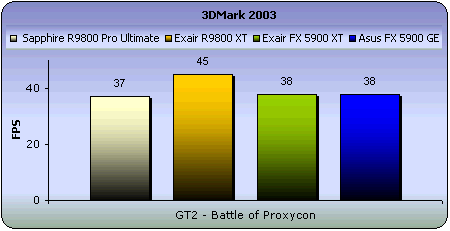VGA Roundup
6. 3DMark Benchmark tests
Review Pages
2. Exair Radeon 9800 XT
3. Asus V9950 FX 5900 GE
4. Exair GeForce FX 5900 XT
5. Test specifications
6. 3DMark Benchmark tests
7. Aquamark3 Benchmark tests
8. Codecreatures Benchmark tests
9. GL Excess Benchmark tests
10. Farcry & Painkiller tests
11. Unreal Tournament 2004 & 2003 tests
12. Halo & Tomb Raider:AOD tests
13. Overclocking
14. Conclusion
3DMark 2003 Build 340
 Although
3DMark is a widely known Direct 3D benchmarking software, we don't recommend
it for making concluding decisions about the performance
of a VGA card. During 2003 an issue arose, regarding 3DMark's reliability.
It was found that Nvidia tweaked its VGA cards in order to show better
results with 3DMark. This of course was a great cheat on users and a also
a substantial blast for 3Dmark. Madonion, 3DMark's manufacturer, unveiled
patches for its software correcting Nvidia's foxy cheat.
Although
3DMark is a widely known Direct 3D benchmarking software, we don't recommend
it for making concluding decisions about the performance
of a VGA card. During 2003 an issue arose, regarding 3DMark's reliability.
It was found that Nvidia tweaked its VGA cards in order to show better
results with 3DMark. This of course was a great cheat on users and a also
a substantial blast for 3Dmark. Madonion, 3DMark's manufacturer, unveiled
patches for its software correcting Nvidia's foxy cheat.
The fact is that 3DMark has lost its former glory and many users have stopped trusting it solely. But to be fair it is still a good software for testing a VGA card's capabilities and in our opinion it should not be missing from the user's view.
3Dmark03 is consisted of 4 game benchmarks, sound tests, CPU and feature tests. In this page we offer the average FPS comparison on the game benchmarks, the fillrate test and the pixel shader 2.0 feature tests.
- Game Test 1 - Wings of Fury (DX7)
 This test is a combat flight simulator written for older hardware
(DirectX 7). Particles are used a lot in this test - smoke and vapour trails,
flak and gunfire, and explosions are produced using point sprites and quads.
This test is a combat flight simulator written for older hardware
(DirectX 7). Particles are used a lot in this test - smoke and vapour trails,
flak and gunfire, and explosions are produced using point sprites and quads.
There are plenty planes but their polygon frame rate is low, as well as single textured background object are used. Hence the average fps (frames per second) are high for all cards.

No minor performance differences, since the DX7 doesn't consume much power of the newest VGA cards. It is visible though, that the ATI cards performed better on this test.
 - Game Test 2 - Battle of Proxycon (DX8)
- Game Test 2 - Battle of Proxycon (DX8)
This test is a simulation of first person shooter game types. 1.1 and 1.4 Vertex shaders are widely used since all character models are skinned using vertex shaders.
This makes this test a good vertex shader comparison for VGA cards.

The Radeon 9800 XT shows its teeth on this test, proving its great ability handling vertex shaders.
- Game Test 3 - Trolls' Lair (DX8)
 This
test should be the favorite of all RPG lovers. It is a cut scene of a female
warrior facing two malicious trolls. Again the same
vertex and pixel processing is used as in game test 2.
This
test should be the favorite of all RPG lovers. It is a cut scene of a female
warrior facing two malicious trolls. Again the same
vertex and pixel processing is used as in game test 2.
This test also uses
post-processing effects, such as Depth
of Field and Bloom effects
which are widely used in today's game cut scene sequences.

Identical fps for the Nvidia cards. Here again the R9800 XT is on top.
 - Game Test 4 - Mother Nature (DX9)
- Game Test 4 - Mother Nature (DX9)
This game test represents the level of effects and realism that are possible using 2.0 vertex and pixel shaders, plus some other features that DirectX 9 offers.
The Radeon series are slightly more capable processing vertex and pixel shaders 2.0, according to this test.

- 3DMark Official score
If you test your machine with 3DMark you can post the results at 3DMark' online result browser. For more information visit futuremark.com.

From the start of the 3DMark game test series, the Radeon 9800 XT was on top. This is obvious since the Radeon XT model has the highest core and memory frequencies in comparison with the other cards. It's also the only that comes with 256 DDR. So it would surprise us if the Radeon 9800 XT wasn't first!
Review Pages
2. Exair Radeon 9800 XT
3. Asus V9950 FX 5900 GE
4. Exair GeForce FX 5900 XT
5. Test specifications
6. 3DMark Benchmark tests
7. Aquamark3 Benchmark tests
8. Codecreatures Benchmark tests
9. GL Excess Benchmark tests
10. Farcry & Painkiller tests
11. Unreal Tournament 2004 & 2003 tests
12. Halo & Tomb Raider:AOD tests
13. Overclocking
14. Conclusion













